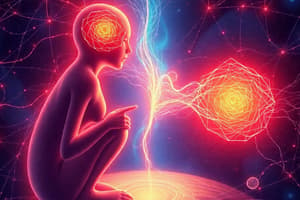Podcast
Questions and Answers
Which system is responsible for mediating the sensations of touch, pain, and temperature?
Which system is responsible for mediating the sensations of touch, pain, and temperature?
- Exteroceptive system (correct)
- Cerebroceptive system
- Proprioceptive system
- Interoceptive system
Which sensory receptor is primarily responsible for conveying sensations about pain and temperature changes?
Which sensory receptor is primarily responsible for conveying sensations about pain and temperature changes?
- Ruffini endings
- Pacinian corpuscles
- Free nerve endings (correct)
- Merkel’s disks
Where do sensory nerves from the upper regions of the skin enter the spinal cord?
Where do sensory nerves from the upper regions of the skin enter the spinal cord?
- At the lumbar region
- At the top levels of the spinal cord (correct)
- At the thoracic level
- At the middle of the spinal cord
What type of sensation does the proprioceptive system primarily monitor?
What type of sensation does the proprioceptive system primarily monitor?
What happens when stimuli are applied to the sensory receptors in the skin?
What happens when stimuli are applied to the sensory receptors in the skin?
Which of the following correctly describes Merkel’s disks?
Which of the following correctly describes Merkel’s disks?
What type of receptor conveys sensations related to sudden changes in skin pressure?
What type of receptor conveys sensations related to sudden changes in skin pressure?
Which spinal cord region do sensory nerves from the lower body enter?
Which spinal cord region do sensory nerves from the lower body enter?
What is a dermatome?
What is a dermatome?
Which system is responsible for relaying sensations of touch and proprioception to the primary somatosensory cortex?
Which system is responsible for relaying sensations of touch and proprioception to the primary somatosensory cortex?
What concept explains why some body areas have more cortical representation than others?
What concept explains why some body areas have more cortical representation than others?
Which part of the brain is most frequently linked to the emotional reaction to pain?
Which part of the brain is most frequently linked to the emotional reaction to pain?
What type of pain is characterized by severe, chronic pain in the absence of actual pain stimuli?
What type of pain is characterized by severe, chronic pain in the absence of actual pain stimuli?
What is the role of the periaqueductal grey in pain perception?
What is the role of the periaqueductal grey in pain perception?
Which of the following is NOT an example of cognitive factors influencing pain perception?
Which of the following is NOT an example of cognitive factors influencing pain perception?
What is the ventral stream responsible for?
What is the ventral stream responsible for?
Which brain structures contribute to pain perception but are not directly responsible for sensing pain?
Which brain structures contribute to pain perception but are not directly responsible for sensing pain?
What role do microglia play in neuropathic pain?
What role do microglia play in neuropathic pain?
Which area of the brain is primarily involved in extending the integration of information from different sensory modalities?
Which area of the brain is primarily involved in extending the integration of information from different sensory modalities?
What does cortical magnification refer to in the context of the primary somatosensory cortex?
What does cortical magnification refer to in the context of the primary somatosensory cortex?
Which system is mainly responsible for relaying pain and temperature sensations?
Which system is mainly responsible for relaying pain and temperature sensations?
How do cognitive and emotional factors influence pain perception?
How do cognitive and emotional factors influence pain perception?
What is the function of the periaqueductal grey in the pain circuit?
What is the function of the periaqueductal grey in the pain circuit?
What phenomenon might explain why individuals may not feel pain immediately after a traumatic injury?
What phenomenon might explain why individuals may not feel pain immediately after a traumatic injury?
What triggers neuropathic pain after an injury?
What triggers neuropathic pain after an injury?
Which organizational structure in the brain is responsible for the specific representation of body sensation?
Which organizational structure in the brain is responsible for the specific representation of body sensation?
What are the two streams of information processed from the S1 to the S2?
What are the two streams of information processed from the S1 to the S2?
What aspect of pain perception is NOT specifically linked to direct perception itself?
What aspect of pain perception is NOT specifically linked to direct perception itself?
What type of receptor is responsible for conveying sensations about gradual stretch of the skin?
What type of receptor is responsible for conveying sensations about gradual stretch of the skin?
Which type of sensory stimulation is primarily associated with the nociceptive system?
Which type of sensory stimulation is primarily associated with the nociceptive system?
How do sensory receptors in the skin generate an action potential in response to stimuli?
How do sensory receptors in the skin generate an action potential in response to stimuli?
What path do sensory nerves from the middle regions of the body follow when entering the spinal cord?
What path do sensory nerves from the middle regions of the body follow when entering the spinal cord?
Which characteristic describes the exteroceptive system?
Which characteristic describes the exteroceptive system?
Which spinal cord entries correspond to the top portion of the body?
Which spinal cord entries correspond to the top portion of the body?
What does the proprioceptive system primarily monitor?
What does the proprioceptive system primarily monitor?
Which of the following best defines the role of free nerve endings in the somatosensory system?
Which of the following best defines the role of free nerve endings in the somatosensory system?
Flashcards are hidden until you start studying
Study Notes
Somatosensation Overview
- Mediates bodily sensations through interrelated somatosensory systems: exteroceptive, proprioceptive, and interoceptive.
- Exteroceptive system processes touch, pain, and temperature, while proprioceptive focuses on body position and balance, and interoceptive senses internal bodily conditions.
Peripheral Pathways
- Exteroceptive system responds to three external stimuli:
- Mechanical (touch)
- Thermal (temperature)
- Nociceptive (pain)
- Four types of sensory receptors in the skin:
- Free nerve endings: detect pain and temperature changes.
- Pacinian corpuscles: sense sudden skin pressure changes.
- Merkel’s disks: respond to gradual pressure on the skin.
- Ruffini endings: sense gradual skin stretch.
- Receptor activation changes cell membrane permeability leading to action potential generation that travels through sensory neurons to spinal cord.
Sensory Nerve Pathways
- Entry points into the spinal cord vary based on body region:
- Upper body nerves enter at higher spinal levels.
- Middle body nerves enter at thoracic levels.
- Lower body nerves enter at lumbar and sacral regions.
- Dermatomes represent specific skin sections corresponding to spinal segments, with overlapping sensory innervation.
Central Pathways
- Dr. Wilder Penfield’s research electrically stimulated regions of the post-central gyrus, mapping the primary somatosensory cortex (S1).
- S1 organization mirrors body surface, with cortical magnification for areas like hands, lips, and tongue.
- Peripheral nerves follow two major pathways to S1:
- Dorsal column medial lemniscus system: processes touch and proprioception.
- Anterolateral system: handles pain and temperature sensations.
- Sensory information flows from S1 to S2 and posterior parietal lobe, split into two streams:
- Dorsal stream: integrates sensory inputs, directing attention to external events.
- Ventral stream: processes object shape perception.
Pain Perception
- No single locus for pain perception; multiple brain areas are involved:
- Thalamus, primary and secondary somatosensory cortices, insula, anterior cingulate cortex.
- These areas link to expectations and emotional responses to pain rather than direct pain perception.
- Cognitive and emotional factors can suppress pain:
- Religious ceremonies may demonstrate reduced pain response to physical harm.
- Soldiers and individuals in life-threatening situations often experience diminished pain awareness until safety is restored.
Pain Circuitry
- The periaqueductal gray contains opioid receptors activated by endorphins, blocking pain signals by:
- Activating the raphe nuclei, stimulating spinal interneurons to inhibit pain signal transmission to the brain.
Neuropathic Pain
- A distinct type of severe chronic pain experienced without immediate nociceptive stimuli, often following injury.
- Microglial activation leads to neuropathic changes post-injury that can induce lingering pain.
- Past experiences and epigenetics influence neuropathic pain mechanisms, primarily affecting prefrontal and anterior cingulate cortex functions.
Somatosensation Overview
- Mediates bodily sensations through interrelated somatosensory systems: exteroceptive, proprioceptive, and interoceptive.
- Exteroceptive system processes touch, pain, and temperature, while proprioceptive focuses on body position and balance, and interoceptive senses internal bodily conditions.
Peripheral Pathways
- Exteroceptive system responds to three external stimuli:
- Mechanical (touch)
- Thermal (temperature)
- Nociceptive (pain)
- Four types of sensory receptors in the skin:
- Free nerve endings: detect pain and temperature changes.
- Pacinian corpuscles: sense sudden skin pressure changes.
- Merkel’s disks: respond to gradual pressure on the skin.
- Ruffini endings: sense gradual skin stretch.
- Receptor activation changes cell membrane permeability leading to action potential generation that travels through sensory neurons to spinal cord.
Sensory Nerve Pathways
- Entry points into the spinal cord vary based on body region:
- Upper body nerves enter at higher spinal levels.
- Middle body nerves enter at thoracic levels.
- Lower body nerves enter at lumbar and sacral regions.
- Dermatomes represent specific skin sections corresponding to spinal segments, with overlapping sensory innervation.
Central Pathways
- Dr. Wilder Penfield’s research electrically stimulated regions of the post-central gyrus, mapping the primary somatosensory cortex (S1).
- S1 organization mirrors body surface, with cortical magnification for areas like hands, lips, and tongue.
- Peripheral nerves follow two major pathways to S1:
- Dorsal column medial lemniscus system: processes touch and proprioception.
- Anterolateral system: handles pain and temperature sensations.
- Sensory information flows from S1 to S2 and posterior parietal lobe, split into two streams:
- Dorsal stream: integrates sensory inputs, directing attention to external events.
- Ventral stream: processes object shape perception.
Pain Perception
- No single locus for pain perception; multiple brain areas are involved:
- Thalamus, primary and secondary somatosensory cortices, insula, anterior cingulate cortex.
- These areas link to expectations and emotional responses to pain rather than direct pain perception.
- Cognitive and emotional factors can suppress pain:
- Religious ceremonies may demonstrate reduced pain response to physical harm.
- Soldiers and individuals in life-threatening situations often experience diminished pain awareness until safety is restored.
Pain Circuitry
- The periaqueductal gray contains opioid receptors activated by endorphins, blocking pain signals by:
- Activating the raphe nuclei, stimulating spinal interneurons to inhibit pain signal transmission to the brain.
Neuropathic Pain
- A distinct type of severe chronic pain experienced without immediate nociceptive stimuli, often following injury.
- Microglial activation leads to neuropathic changes post-injury that can induce lingering pain.
- Past experiences and epigenetics influence neuropathic pain mechanisms, primarily affecting prefrontal and anterior cingulate cortex functions.
Studying That Suits You
Use AI to generate personalized quizzes and flashcards to suit your learning preferences.



